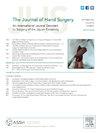Reliability of Wrist Arthroscopy in the Diagnosis and Treatment of Triangular Fibrocartilage Complex Tears
IF 2.1
2区 医学
Q2 ORTHOPEDICS
引用次数: 0
Abstract
Purpose
Wrist arthroscopy is considered the gold standard for diagnosis of intra-articular wrist conditions including triangular fibrocartilage complex (TFCC) tears; however, the ability to reliably diagnose TFCC pathology during wrist arthroscopy is unclear. The purpose of this study was to assess the reliability of the diagnosis of TFCC tears on wrist arthroscopy videos.
Methods
Five hand surgeons reviewed 43 cases on a secure web-based platform at two time points separated by 4–6 weeks. Each case included a deidentified clinical vignette and wrist radiographs with ulnar variance measurements and an arthroscopy video of ulnar wrist pathology, averaging 42 seconds. Surgeons were queried on the presence of TFCC tear and Palmer and Atzei classifications. Interobserver/intraobserver reliabilities were determined using kappa coefficients.
Results
The interobserver reliability regarding the presence/absence of TFCC tear was fair-good, with kappa coefficients of 0.596 in the first round of case review and 0.708 in the second round. The overall intraobserver reliability for the presence/absence of TFCC tear was also fair-good, with a kappa coefficient of 0.567. For cases with central TFCC tears, the interobserver reliability regarding the presence of TFCC tear was perfect, with a kappa coefficient of 1.0. When central tears were excluded, the kappa coefficients decreased to 0.322 and 0.368 in each round. The interobserver reliability for the Palmer and Atzei classifications was low, with kappa coefficients of 0.220 and 0.121 in the first round and 0.222 and 0.123 in the second round.
Conclusions
Experienced wrist arthroscopy surgeons demonstrated fair-good interobserver reliability for the diagnosis of TFCC tear on wrist arthroscopy. However, when central TFCC tears were excluded, interobserver reliability was poor. These findings demonstrate a need for a focus on education for wrist arthroscopy anatomy.
Clinical relevance
This investigation demonstrated poor agreement in surgeon identification and classification of TFCC tears, aside from central TFCC tears. The low reliability has a direct bearing on treatment considerations for TFCC tears.
腕关节镜在诊断和治疗三角纤维软骨复合体撕裂中的可靠性。
目的:腕关节镜被认为是诊断包括三角纤维软骨复合体(TFCC)撕裂在内的腕关节内病变的金标准;然而,在腕关节镜检查过程中可靠诊断TFCC病变的能力尚不明确。本研究旨在评估腕关节镜视频诊断 TFCC 撕裂的可靠性:方法:五名手外科医生在一个安全的网络平台上对 43 个病例进行了审查,两个时间点相隔 4-6 周。每个病例都包括一个身份不明的临床小故事、带有尺侧方差测量值的腕部X光片以及尺侧腕部病变的关节镜视频,平均时长为42秒。外科医生被询问是否存在TFCC撕裂以及帕尔默和阿策分类。使用卡帕系数确定观察者间/观察者内的可靠性:第一轮病例审查的卡帕系数为 0.596,第二轮病例审查的卡帕系数为 0.708。观察者内部对是否存在 TFCC 撕裂的总体可靠性也为尚好,卡帕系数为 0.567。对于有中央 TFCC 撕裂的病例,TFCC 撕裂存在与否的观察者间可靠性是完美的,卡帕系数为 1.0。如果排除中央撕裂,每轮的卡帕系数分别降至 0.322 和 0.368。Palmer和Atzei分类的观察者间可靠性较低,第一轮的卡帕系数分别为0.220和0.121,第二轮的卡帕系数分别为0.222和0.123:结论:经验丰富的腕关节镜外科医生在腕关节镜下诊断TFCC撕裂的观察者间可靠性尚可。然而,如果排除中央 TFCC 撕裂,观察者之间的可靠性较差。这些发现表明,有必要重点开展腕关节镜解剖学教育:临床相关性:这项研究表明,除TFCC中央撕裂外,外科医生对TFCC撕裂的识别和分类的一致性很差。可靠性低直接影响到TFCC撕裂的治疗考虑因素。
本文章由计算机程序翻译,如有差异,请以英文原文为准。
求助全文
约1分钟内获得全文
求助全文
来源期刊
CiteScore
3.20
自引率
10.50%
发文量
402
审稿时长
12 weeks
期刊介绍:
The Journal of Hand Surgery publishes original, peer-reviewed articles related to the pathophysiology, diagnosis, and treatment of diseases and conditions of the upper extremity; these include both clinical and basic science studies, along with case reports. Special features include Review Articles (including Current Concepts and The Hand Surgery Landscape), Reviews of Books and Media, and Letters to the Editor.

 求助内容:
求助内容: 应助结果提醒方式:
应助结果提醒方式:


